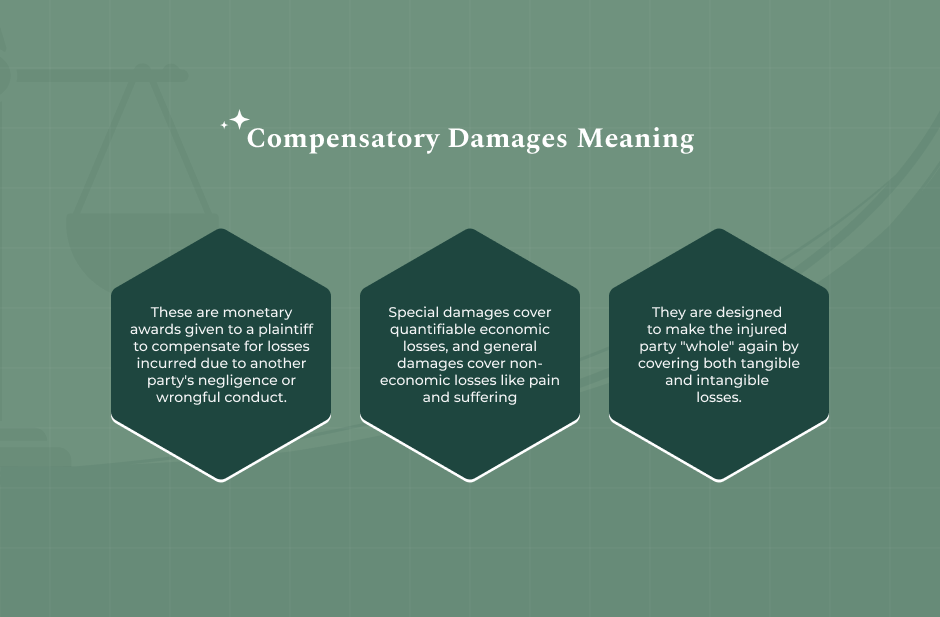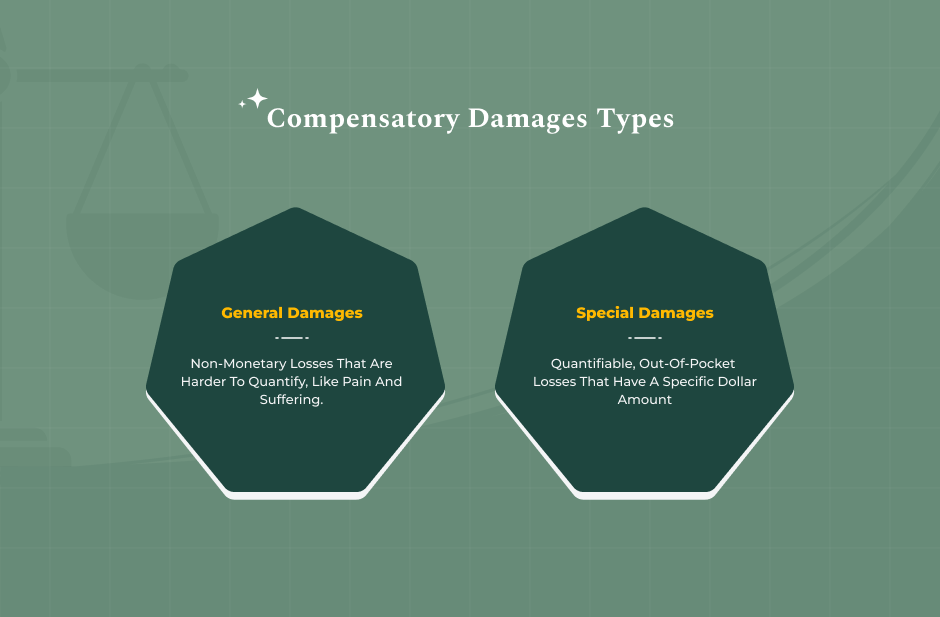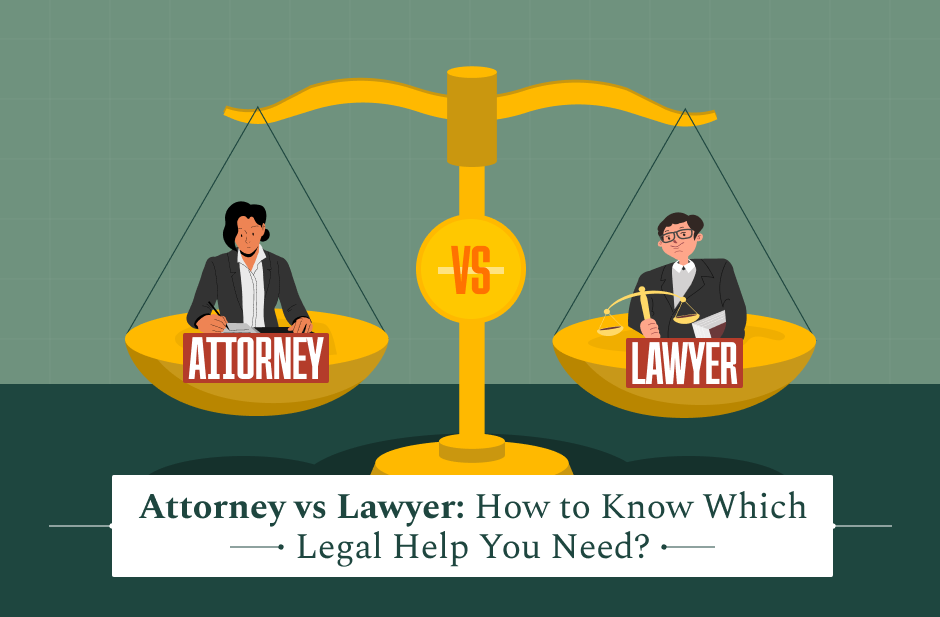A lawsuit is looking for justice. Justice typically translates into money. That money judgment is typically compensatory damages. So, what are compensatory damages? They are money judgments used to put a plaintiff back in the position he was before he was injured by another’s or organization’s wrongful act.
If you are looking for a simple compensatory damages definition, “actual damages” best describes it. The general intent of what are compensatory damages is straightforward: Your aim is to make the injured party “whole.” They try to put the plaintiff in the same position he was in prior to injury. Of course this happens to the greatest degree possible using money.
This in-depth article will describe what are compensatory damages, the various types, and how they are calculated in court. You will understand how they are different from other awards such as punitive vs compensatory damages. We will also describe the nuances that go into deciding these important legal awards.
What Are Compensatory Damages?

The definition of compensatory damages is really at the core of United States and world civil law. They make an injured party have to pay financially for the result of their conduct.
The Compensatory Principle
The intention of the law is to compensate for the loss, rather than punishing the perpetrator. This is the meaning of compensatory damages. A judge has to provide an amount equivalent to the proven loss by the plaintiff.
It will not end up making the plaintiff a beneficiary of the case. The compensation should be proportionate and based on facts. This is a common law basis in every jurisdiction.
Compensatory vs Punitive Damages
It is important to differentiate between compensatory vs punitive damages.
Compensatory Damages
These are for actual losses. They are meant to indemnify the plaintiff. It means money for medical expenses, lost wages, and suffering.
Punitive Damages
They are over-compensation damages. Moreover, they are aimed at punishing the defendant for extremely negligent or malicious behavior. They also help deter others from doing so.
Even the US Supreme Court has imposed constitutional restrictions on the ratio of punitive to compensatory damages, according to the State Farm v. Campbell case.
When individuals inquire what are compensatory damages, they are inquiring about money for their real damages.
The Two Primary Forms of Compensatory Damages

Compensatory damages are split into two large categories depending upon the ease with which the loss can be quantified.
1. Economic Damages (Special Damages)
Economic damages are the simplest to determine. They comprise concrete, out-of-pocket expenses. They are also referred to as special damages as they refer specifically to the precise facts of the plaintiff’s loss.
Now, let us look into compensatory damages in the economic type
- Medical Expense: Charges for visits to the doctor, time in the hospital, surgery, medications, and physical therapy.
- Income Lost and Future Income Lost: Money the plaintiff has actually lost due to the injury keeping them from working. This includes the value of future income the plaintiff is expected to lose.
- Destroyed Property: It costs to fix or replace property that was ruined, like a house or automobile.
- Cost of Necessary Services: Payments made for items like child care or home services that the injured plaintiff requires as a consequence of the injury.
Such figures are determined by bills, receipts, and expert estimates based on economists.
2. Non-Economic Damages (General Damages)
Non-economic damages are losses which are personal in nature and cannot be quantified by any receipt. They are also referred to as general damages. It is much harder to determine the value of such damages.
Now let us look into compensatory damages in the non-economic category.
- Physical pain and suffering: Award for physical pain and agony which are caused by the injury.
- Mental distress: Award for depression, anxiety, fear, and other ill effects on the mind.
- Loss of enjoyment of life: Award for inability to enjoy hobbies, sporting activities, or activities of daily living.
- Loss of consortium: Award to the spouse or family for loss of love, services, or companionship.
Courts will apply techniques such as the multiplier method or per diem method to find out what are compensatory damages. It is done by multiplying economic damages by a multiplier or by awarding a per diem rate for suffering.
Compensatory Damages In Tort Law vs. Contract Law
The legal setting of a claim dictates the application of what are compensatory damages. They appear in two broad areas of law.
Compensatory Damages In Tort Law
Tort law addresses civil wrongs, such as negligence (e.g., auto accidents), battery, or slander. What are compensatory damages in tort is to bring the plaintiff back to where he was before the wrongdoing in terms of physically and financially.
This is where personal injury actions, such as pain and suffering, are customary.
Compensatory Damages In Contract Law
When the contract is broken, compensatory damages are equally the default remedy. But the emphasis is somewhat different. Under contracts, the expectation is to offer expectation damages.
This places the non-breaching party in the economic position they would have enjoyed had the contract been fulfilled. This typically does not include non-economic damages such as pain and suffering.
Of central importance is consequential damages. They are the damages naturally flowing from the breach but are not the direct cost of the breach itself. These are recoverable only where they were foreseeable to the party in breach at the time of contract formation.
Determining And Quantifying Compensatory Damages
The burden of proof is on the plaintiff. They must present enough evidence to substantiate their argument for what compensatory damages are.
The Burden Of Proof
The plaintiff must prove two things by a preponderance of the evidence:
1. That the defendant’s wrongful act caused the injury.
2. The monetary amount of the loss.
Admissible evidence such as medical reports, expert witness statements (by physicians or vocational experts), and financial status statements are all important to prove what are damages which are compensatory damages.
The Duty To Mitigate Damages
One of the most important principles capping what are compensatory damages is the duty to mitigate. The injured party should try their best to reduce their damages after the date of injury.
For instance, a worker who has been dismissed in contravention of contract should try to find a new job. They do not just stay home and run up the damages. Refusal to mitigate can lower the ultimate award of compensatory damages.
Statutory Caps And Limits
Numerous US states have established statutory limits on so-called compensatory damages, better known as non-economic damages, in a variety of types of cases such as medical malpractice.
The limits cap the amount recoverable by a jury for pain and suffering based on no consideration of the magnitude of the injury.
Compensatory Damages Example
To illustrate, consider that a motorist injures a person and fractures his leg in a motor vehicle accident. The court must determine how much money the responsible party owes. This is referred to as compensatory damages. The court starts with the straightforward-to-numerate losses, the dollar bills.
For example, the hospital bills (medical expenses) could be $50,000. The wages the person lost because they weren’t employed (lost wages) could be another $10,000.
Finally, the court awards compensation for the more difficult-to-quantify damages, like the actual pain and suffering that the individual experienced. The judge or jury may award $30,000 for this.
When you add all these figures together, namely:
- Medical expenses.
- Lost wages.
- Suffering compensation.
Therefore, this is an example of compensatory damages. It illustrates that the court would award $90,000. This joint award should compensate the individual for their actual loss and put them in the same position as before.
Frequently Asked Questions (FAQs):
By learning what compensatory damages are, you know the general function of civil law: putting money back. They are the stepping stone for money to return to the plaintiff’s life before the harm.
Economic damages are quantifiable losses with a definite dollar figure, established by proof such as receipts. Medical expenses and lost wages are illustrations.
Non-economic damages are abstract losses such as pain, suffering, and emotional distress. Moreover, they are much more difficult to estimate and are subject to subjective determination by a jury or judge. Both are part of what are compensatory damages.
Courts and jurors set non-economic damages subjectively. Two most widely used methods are the Multiplier Method, where the multiplier (e.g., 1.5 to 5) is multiplied by the number of economic damages.
Next, there is the Per Diem Method, where a per diem dollar figure is assigned for period of pain. The purpose is to get reasonable compensatory damages for plaintiff’s pain.
In most states, statutory limits, typically on the award of non-economic compensatory damages for medical malpractice or some personal injury of a certain type, exist. The limits are quite different state by state but place an upper dollar limit on pain and suffering awards.

















